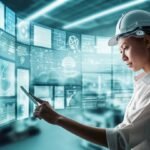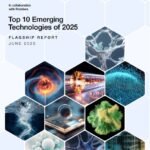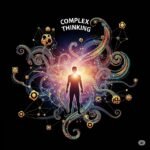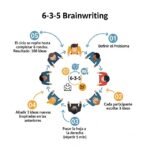
As the world undergoes a technological revolution, the concept of Society 5.0, also known as the Super Smart Society, emerges as a visionary roadmap for the future of human civilization. This innovative initiative envisions a society where technology seamlessly integrates into every aspect of life, empowering individuals and communities to thrive in an era of unprecedented interconnection and innovation.
The rise of Industry 4.0, Industry 5.0, and Society 5.0 signifies an unparalleled technological revolution that integrates the physical, digital, and biological realms (Rane, 2023), thus shaping a new global landscape.
Moreover, Society 5.0 serves as a new guiding principle for innovation (Carayannis and Morawska-Jancelewicz, 2022), and akin to Industry 5.0, it is the most inclusive development to bolster efforts to achieve the Sustainable Development Goals (Kasinathan et al., 2022) proposed by the United Nations. This article explores the concept of Society 5.0, its key characteristics, and the challenges and opportunities it presents.
The Path from Society 1.0 to Society 5.0
The concept of Society 5.0 does not arise in a vacuum. It is the culmination of a long journey through various social stages, each profoundly affected by different technological advancements.
Society 1.0: Nomadic Hunter-Gatherers
Our history begins with Society 1.0, an era dominated by nomadic hunter-gatherers. These resourceful individuals roamed specific territories, relying on their environment for sustenance. Survival was a constant challenge that demanded continual adaptation. This non-productive economy relied on collaboration: groups shared knowledge and used tools crafted from stone and bone for hunting and gathering.
Society 2.0: The Rise of Agriculture and Settled Communities
The advent of agriculture marked a turning point and heralded the beginning of Society 2.0. Crops and livestock enabled the formation of larger sedentary communities near rivers and fertile lands. Permanent dwellings replaced makeshift shelters, and people became self-sufficient, depending on what they could grow and raise. Bartering emerged as a form of exchange, wherein communities traded goods such as gemstones, fruits, and grains.
Society 3.0: The Industrial Revolution and Mass Production
The Industrial Revolution marked the onset of Society 3.0, a period of immense change. Factories and machines revolutionized production, replacing manual labor and fostering mass production. This economic transformation had profound social implications. The concept of social class emerged, wherein material possessions defined economic status. Workers began receiving wages, introducing a novel concept of income.
Society 4.0: The Information Age and the Power of Connectivity
Society 4.0, the Information Age, shifted focus towards easily accessible information. Social, cultural, and economic activities centered around people and interconnection. Information and communication technologies (ICTs) facilitate the rapid and accurate flow of information worldwide. This revolution included instant access to information through search engines like Google and social media platforms that kept people constantly updated on global events. Organizations embraced automation to optimize resource utilization, paving the way for digital marketing and innovative customer acquisition strategies.
Steps Toward Society 5.0
These distinct societies serve as steps leading us toward the ambitious vision of Society 5.0. Each era brought its own advancements, challenges, and social transformations. We can glean valuable lessons from these historical transitions as we strive to build a future where humans and technology coexist harmoniously in a hyperconnected world.

What is Society 5.0?
The concept of Society 5.0 was proposed in Japan’s 2016 V Basic Plan for Science and Technology by the Government of Japan as “a human-centered society in which economic development and the resolution of social issues are compatible through a highly integrated system of cyberspace and physical space.” The 2021 VI Basic Plan for Science, Technology, and Innovation describes Society 5.0 as “a society that is sustainable and resilient to threats and unpredictable and uncertain situations, ensuring the safety of individuals and the achievement of diverse well-being.”
Society 5.0, also known as the Super Smart Society, requires us to rethink two types of relationships: the relationship between technology and society and the technology-mediated relationship between individuals and society (Deguchi et al., 2020). It aims to harness technological advancements to finally address the problems currently threatening Japan, such as aging, low birth rates, and lack of competitiveness, among others (Narvaez et al., 2021).
Mourtzis et al. (2023) indicate that human-machine interaction (HMI) is a crucial aspect of Society 5.0, in which technology is leveraged to address social challenges and enhance quality of life. In summary, we can assume that Society 5.0 aims to put technology in the service of citizens’ well-being.
The Foundation of a Super Smart Society
At the heart of Society 5.0 lies the concept of a Super Smart Society, a world where physical and digital spaces converge to create a hyper-intelligent ecosystem. This intelligent infrastructure will enable real-time data collection, analysis, and decision-making, empowering individuals and institutions to solve complex problems, optimize resource allocation, and enhance overall well-being.
According to Deguchi et al. (2020), Society 5.0 will feature an iterative cycle where data is collected, analyzed, and then turned into meaningful information, which is then applied in the real world. Moreover, this cycle operates at the societal level.
Hyperconnectivity at the Core of Society 5.0
Society 5.0 is driven by hyperconnectivity, the seamless integration of the Internet of Things (IoT), artificial intelligence (AI), and big data. This pervasive network will connect people, devices, and systems, enabling the exchange of vast amounts of information and facilitating real-time collaboration.
People-Centered Innovation: The Driving Force
Society 5.0 is not simply about technological advancements; it is a human-centered approach that prioritizes the well-being and empowerment of individuals. This philosophy emphasizes the co-creation of solutions, fostering collaboration among diverse stakeholders to address social challenges and shape a future that benefits everyone.
Harnessing the Potential of Society 5.0
Society 5.0 has immense potential to transform various aspects of human life, from healthcare and education to transportation and agriculture. Let’s explore some of the key areas where Society 5.0 is poised to have a significant impact.
Unleashing Human Potential for a Better Future
Society 5.0 aims to unlock the full potential of human beings by providing them with access to tools, resources, and personalized support systems. This will enable people to pursue their passions, develop their skills, and make meaningful contributions to society.
Addressing Social Challenges with Technological Solutions
Society 5.0 offers a powerful framework for addressing social challenges such as population aging, environmental degradation, and economic inequality. By harnessing the power of technology, we can develop innovative solutions that tackle these pressing issues and create a more sustainable and equitable future.
According to Pereira et al. (2020), the Super Smart Society has a special focus on positioning the human being at the center of innovation, technological transformation, and industrial automation, driven by Industry 4.0.
Co-Creation: Fostering Collaboration for Progress
Co-creation is a fundamental principle of Society 5.0, emphasizing the importance of collaboration among diverse stakeholders to solve complex problems. This approach brings together the expertise of individuals, communities, businesses, and governments to foster innovation and drive positive change.
In this regard, Carayannis and Morawska-Jancelewicz (2022) state that innovations arise as a result of cooperative activities, and networks, clusters, or common values and interests are key to their creation. Thus, the super-smart society becomes a “breeding ground” for social innovations.
Embracing Digital Transformation
Society 5.0 represents an extension of Industry 4.0, the ongoing transformation of industrial processes through digital technologies. While Industry 4.0 focuses on optimizing manufacturing and production, Society 5.0 expands this concept to encompass all aspects of society, creating a holistic, human-centered approach to technological advancement.
The Role of AI, IoT, and Big Data in Shaping Society 5.0
Artificial intelligence (AI), the Internet of Things (IoT), and big data play a crucial role in making Society 5.0 possible. AI algorithms will analyze large amounts of data collected from IoT devices, providing insights that can inform decision-making, optimize processes, and personalize experiences.
Industry 4.0 vs. Society 5.0
Society 5.0 focuses on using tools and technologies developed by Industry 4.0 for the benefit of humanity (Pereira et al., 2020). By adopting the principles of Society 5.0, we can navigate this transformative era and ensure that technology serves as a force for good, empowering people and communities to thrive in a rapidly evolving world.
Deguchi et al. (2020) highlight that both Industry 4.0 and Society 5.0 emphasize the use of technology, including IoT-related technology, artificial intelligence, and big data analysis; and involve a top-down approach, led by the state, with collaboration between industry, academia, and the governmental sector. On the other hand, Nair et al. (2021) indicate that Industry 4.0 focuses on the metamorphosis of all industrial components with the help of strong digital support, while Society 5.0 implies a human-centered community capable of achieving a balance between economic proliferation and resolving social liabilities through the central combination of cyber and physical space.
Regarding differences, Industry 4.0 advocates for smart factories, whereas Society 5.0 advocates for a superintelligent society (Deguchi et al., 2020); in other words, Industry 4.0 is implemented in the manufacturing environment, while in Society 5.0, it will be implemented throughout society.
Industry 5.0 vs. Society 5.0
Kasinathan et al. (2022) highlighted the potential of disruptive technologies of Industry 5.0 and Society 5.0 as the most inclusive development to bolster efforts to achieve the Sustainable Development Goals; and proposes an integrated framework to include technologies of the new era to establish the concepts of Industry 5.0 and Society 5.0 integrated into smart cities and towns.
The vision of Industry 5.0 is to create a manufacturing environment that is highly efficient, sustainable, and socially responsible, promoting the well-being of both workers and communities while driving economic growth (Mourtzis et al., 2023). Human centrality is an important element in both Industry 5.0 and Society 5.0 (Huang et al., 2022).
Addressing Challenges and Ethical Considerations
As we embark on the journey towards Society 5.0, it is crucial to address potential challenges and ethical considerations that arise from this transformative vision.
Ensuring Privacy and Security in a Hyperconnected World
In a hyperconnected world, protecting privacy and ensuring cybersecurity are paramount. Robust data protection measures and ethical AI practices must be implemented to safeguard individuals’ personal information and prevent misuse of technology.
Ethical Implications of Artificial Intelligence
The rapid development of artificial intelligence raises a range of ethical concerns, such as potential biases, algorithmic discrimination, and the impact on human autonomy. It is essential to establish clear ethical guidelines for the development and implementation of AI to ensure that these technologies are used responsibly and by human values.
The Future of Work in Society 5.0
The advent of Society 5.0 will undoubtedly transform the landscape of work, generating challenges and opportunities. As technology becomes increasingly integrated into the workplace, we must adapt our skills and mindsets to thrive in this new environment.
One of the most significant concerns surrounding Super Smart Society is the possibility of automation displacing workers, particularly in repetitive and low-skilled jobs. As AI-driven machines and robots become more sophisticated, they may take on tasks that were previously performed by humans.
To address the challenges of automation, it is essential to invest in upskilling and reskilling initiatives that equip workers with the skills and knowledge needed for the jobs of the future. This includes developing expertise in areas such as artificial intelligence, data analytics, and digital literacy.
New Opportunities in the Knowledge Economy
Society 5.0 will also create new opportunities in the knowledge economy, particularly in fields such as data science, software development, and creative industries. These jobs will require a combination of technical skills, critical thinking, and problem-solving ability.
Çipi et al. (2023) propose a decision support model that can help businesses structure and prioritize new business opportunities within the context of Society 5.0, and the results highlight the most important areas where new business opportunities may arise.
The Role of Education and Training
Education and training systems will need to adapt to prepare people for the demands of Society 5.0. This includes incorporating new technologies into curricula, developing innovative teaching methods, and fostering a culture of lifelong learning.
Legi et al. (2023) emphasize that the transformation of education has become very important in the super smart society, where the need for digital skills, creativity, collaboration, and problem-solving is increasing.
Embracing Lifelong Learning
In an era of rapid technological change, lifelong learning will become increasingly important. People must be prepared to continuously update their skills and knowledge to remain competitive in the job market.
Promoting Inclusive and Equitable Access to Education
It is crucial to ensure inclusive and equitable access to education so that everyone has the opportunity to develop the skills and knowledge they need to participate in the economy of Society 5.0. This includes addressing disparities in access to quality education and providing support to vulnerable populations.
The Role of Governments and Businesses
Governments and businesses play a crucial role in supporting the transition to Society 5.0 by investing in education and training, promoting innovation, and creating policies that support a fair and inclusive labor market.
Examples of Society 5.0 in Action
Smart Cities: Transforming Urban Landscapes
Barrett et al. (2021) describe the implementation of smart cities in Japan within the framework of public policy of Society 5.0. As a result, infrastructure is becoming “infrastructure”: vital systems that are linked, monitored, and managed simultaneously through smart communications.
Revolutionizing Healthcare with Technology
Ciasullo et al. (2022) developed a Health 4.0 solution integrated into a mobile clinical decision support system aimed at merging the divergent purposes of increasing the efficiency of health services and improving the quality of care through co-creation implementation; and it allowed generating a double benefit: a) it enables more effective and timely provision of health services, curbing health exacerbations and addressing access to emergency care, and b) creates a digital empowerment environment for patients and informal caregivers, activating them to act as value co-creators.
Enhancing Education through Digital Innovation
Mansur et al. (2023) report that the Era of Society 5.0 is consistent with designs of inclusive and relevant education learning for Indonesia’s national education system, where everyone can receive quality educational services for the continuation of their lives that are also comfortable, family-friendly, and cooperation-based.
Sustainable Agriculture for a Society 5.0
Bissadu et al. (2024) conducted a systematic literature review within the framework of super smart society to investigate the key drivers, enabling cutting-edge technologies, diverse opportunities, and challenges for the development, adoption, and implementation of Agriculture 5.0.
Conclusion: Embracing the Future of Society 5.0
As we navigate the transformative era of Society 5.0, it is essential to address the future of work with a proactive and adaptable mindset. By embracing lifelong learning, developing new skills, and fostering collaboration, we can ensure that this technological revolution empowers people and communities to thrive in a rapidly changing world.
Super smart societypresents a unique opportunity to reshape our society for the better. By adopting the principles of human-centered innovation, co-creation, and ethical use of technology, we can create a future where technology empowers people, addresses social challenges, and improves the well-being of all. Let’s join forces to make Society 5.0 a reality that benefits all humanity.
References
Barrett, B. F., DeWit, A., & Yarime, M. (2021). Japanese smart cities and communities: Integrating technological and institutional innovation for Society 5.0. Smart Cities for Technological and Social Innovation, 73-94. https://doi.org/10.1016/B978-0-12-818886-6.00005-8
Bissadu, K. D., Sonko, S., & Hossain, G. (2024). Society 5.0 enabled agriculture: Drivers, enabling technologies, architectures, opportunities, and challenges. Information Processing in Agriculture. https://doi.org/10.1016/j.inpa.2024.04.003
Carayannis, E. G., & Morawska-Jancelewicz, J. (2022). The futures of Europe: Society 5.0 and Industry 5.0 as driving forces of future universities. Journal of the Knowledge Economy, 13(4), 3445-3471.
Ciasullo, M. V., Orciuoli, F., Douglas, A., & Palumbo, R. (2022). Putting Health 4.0 at the service of Society 5.0: Exploratory insights from a pilot study. Socio-Economic Planning Sciences, 80, 101163. https://doi.org/10.1016/j.seps.2021.101163
Çipi, A., Fernandes, A. C. R., Ferreira, F. A., Ferreira, N. C., & Meidutė-Kavaliauskienė, I. (2023). Detecting and developing new business opportunities in society 5.0 contexts: A sociotechnical approach. Technology in Society, 73, 102243. https://doi.org/10.1016/j.techsoc.2023.102243
Deguchi, A. et al. (2020). What Is Society 5.0?. In: Society 5.0. Springer, Singapore. https://doi.org/10.1007/978-981-15-2989-4_1
Huang, S., Wang, B., Li, X., Zheng, P., Mourtzis, D., & Wang, L. (2022). Industry 5.0 and Society 5.0—Comparison, complementation and co-evolution. Journal of Manufacturing Systems, 64, 424-428. https://doi.org/10.1016/j.jmsy.2022.07.010
Kasinathan, P., Pugazhendhi, R., Elavarasan, R. M., Ramachandaramurthy, V. K., Ramanathan, V., Subramanian, S., Kumar, S., Nandhagopal, K., Raghavan, R. R., Rangasamy, S., Devendiran, R., & Alsharif, M. H. (2022). Realization of Sustainable Development Goals with Disruptive Technologies by Integrating Industry 5.0, Society 5.0, Smart Cities and Villages. Sustainability, 14(22), 15258. https://doi.org/10.3390/su142215258
Legi, H., Damanik, D., & Giban, Y. (2023). Transforming Education Through Technological Innovation In The Face Of The Era Of Society 5.0. Educenter : Jurnal Ilmiah Pendidikan, 2(2), 102–108. https://doi.org/10.55904/educenter.v2i2.822
Mansur, H., Utama, A. H., Mohd Yasin, M. H., Sari, N. P., Jamaludin, K. A., & Pinandhita, F. (2023). Development of Inclusive Education Learning Design in the Era of Society 5.0. Social Sciences, 12(1), 35. https://doi.org/10.3390/socsci12010035
Mourtzis, D., Angelopoulos, J., & Panopoulos, N. (2023). The Future of the Human–Machine Interface (HMI) in Society 5.0. Future Internet, 15(5), 162. https://doi.org/10.3390/fi15050162
Nair, M. M., Tyagi, A. K., & Sreenath, N. (2021, January). The future with industry 4.0 at the core of society 5.0: Open issues, future opportunities and challenges. In 2021 international conference on computer communication and informatics (ICCCI) (pp. 1-7). IEEE.
Narvaez Rojas, C., Alomia Peñafiel, G. A., Loaiza Buitrago, D. F., & Tavera Romero, C. A. (2021). Society 5.0: A Japanese Concept for a Superintelligent Society. Sustainability, 13(12), 6567. https://doi.org/10.3390/su13126567
Pereira, A. G., Lima, T. M., & Santos, F. C. (2020). Industry 4.0 and Society 5.0: opportunities and threats. International Journal of Recent Technology and Engineering, 8(5), 3305-3308.
Rane, N. (2023). Transformers in Industry 4.0, Industry 5.0, and Society 5.0: Roles and Challenges.
Editor and founder of “Innovar o Morir” (‘Innovate or Die’). Milthon holds a Master’s degree in Science and Innovation Management from the Polytechnic University of Valencia, with postgraduate diplomas in Business Innovation (UPV) and Market-Oriented Innovation Management (UPCH-Universitat Leipzig). He has practical experience in innovation management, having led the Fisheries Innovation Unit of the National Program for Innovation in Fisheries and Aquaculture (PNIPA) and worked as a consultant on open innovation diagnostics and technology watch. He firmly believes in the power of innovation and creativity as drivers of change and development.





